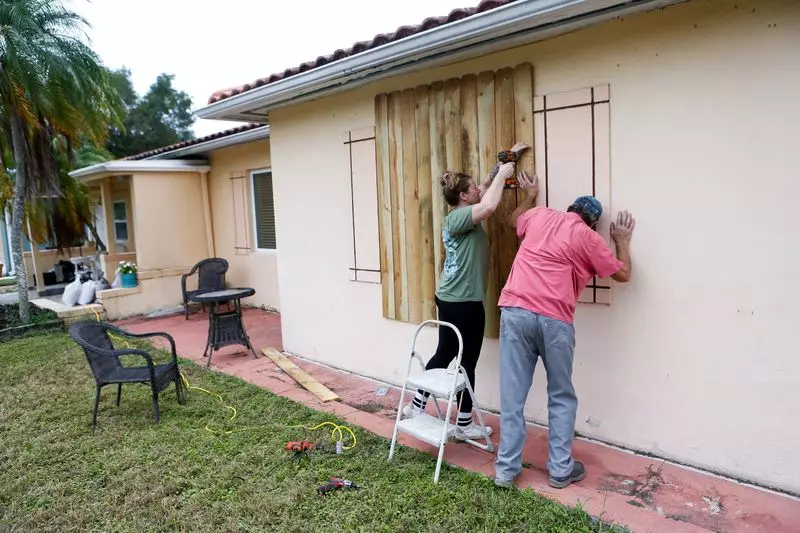As Hurricane Milton approaches Florida, concerns about the already burdened property-insurance market heighten. This situation threatens not just homeowners’ wallets, but the overall stability of a system that is designed to provide safety and security in times of crisis. The hurricane, with its potential for astronomical damage, could catalyze a disastrous escalation in insurance premiums and further expose systemic vulnerabilities in a market that has long faced difficulties.
Hurricane Milton is being classified as a catastrophic event, with wind speeds reaching a devastating 160 mph. Projections indicate that the storm could inflict between $60 billion to $100 billion in insured losses, a staggering amount that reflects the storm’s capacity to wreak havoc. With most of the coastal population caught unprepared and in the aftermath of Hurricane Helene just weeks prior, Floridians are bracing for impact. The combination of a rapid population increase and ongoing environmental challenges makes Florida one of the most treacherous places for homeowners and insurers alike.
The underlying fear is that the fallout from this hurricane will exacerbate the current insurance crisis that has resulted in soaring premiums. Floridians are already bearing an average insurance cost of over $4,000, the highest in the nation, raising serious concerns about the sustainability of coverage in the state. Analysts and experts view this storm not merely as another natural disaster but as a potential tipping point that could signal broader ramifications.
Florida’s property-insurance landscape is a complex web of risk, especially as it faces challenges that stem from both internal and external forces. Inflation rates, extreme weather incidents, and political maneuvers have all contributed to the unpredictability of the market. Some analysts point to these factors as instrumental in shaping the current crisis, which has led to a nationwide increase in property-insurance costs by an aggregate of 31% since 2021.
Many national insurers have turned their backs on Florida’s market. After major hurricanes in the past—like Hurricane Andrew in 1992—insurers have been hesitant to return, leading to a challenging environment where residents often find themselves reliant on smaller providers with insufficient resources to adequately cover claims. With 41 state insurers going bankrupt since 2003, it is evident that instability is rampant and further compounded by the looming threat of Milton.
The backlash against insurance companies is growing, particularly as many providers are reportedly rejecting nearly half of claims made this year. This level of denial is alarming and raises flagrant questions about the very purpose of insurance. It seems that policyholders are often left to fend for themselves.
In the wake of dwindling private-sector options, Citizens Property Insurance Corp was created as a safety net for homeowners unable to secure coverage through traditional channels. As the largest insurer in the state, Citizens boasts $14.4 billion in reserves, ostensibly positioning itself as a reliable bastion in a chaotic market. However, this very reliance on Citizens may lead to future liabilities for Floridians.
Citizens has emergency measures that would allow it to assess surcharges to all policyholders in the event of a major financial shortfall, thereby distributing the burden across every insured individual in the state. This is a worrisome prospect as it displays the precarious balance of Florida’s insurance crisis. As costs continually rise, many residents may find themselves lacking coverage or forced to reduce their policies—options that could leave them exposed in the face of disasters.
Interestingly, despite the precarious situation of the insurance market, demand for real estate in Florida persists. High-end properties continue to attract potential buyers, even against a backdrop of severe weather threats. The contrasting narrative of real estate boom amid an insurance crisis raises questions about the future of Florida’s housing market.
The ties between insurance viability and home affordability are complicated and interwoven. Although banks may require insurance for mortgagors, more homeowners are opting not to carry any coverage when they no longer owe money. This risk not only endangers individual homeowners but collectively threatens the stability of the entire market.
To navigate this unpredictable terrain, an urgent reevaluation of Florida’s property-insurance system is essential. Stakeholders must consider long-term solutions to ensure that policies are both accessible and affordable, ultimately aiming to insulate residents from the devastations of catastrophic storms like Milton.
As Hurricane Milton approaches, the insurance implications will demand scrutiny. With the fate of many dependent on the robust functioning of this system, all eyes will turn to how the market will respond not just to the storm itself, but to the many larger social and economic ramifications it signifies.

